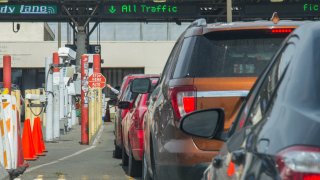
U.S. Customs and Border Protection announced changes to operational hours for SENTRI lanes at the Otay Mesa passenger port of entry.
The new operating hours for SENTRI vehicle lanes will be 4 a.m. to 10 p.m. These changes are due to decreased traffic volume, CBP said.
“Overall, there has been a decrease in northbound traffic at all the land ports of entry on the California border with Mexico. The week of March 2 compared to last week there was an average decrease of 52% in vehicle crossings for a daily average of more than 42,000 vehicles,” CBP said in a release. “We also experienced an average decrease of 76% in a pedestrian crossing, with a daily average of almost 14,000. In addition, last week, 90% - 94% of travelers entering in vehicles and on foot were U.S. citizens or lawful permanent residents.”
The Otay Mesa passenger border crossing is open 24 hours a day. Individuals with SENTRI will be able to use the Ready Lanes at the crossing, designated for travelers with RFID-enabled documents, CBP said.
The change is to the passenger portion of the port of entry, there are no changes to the cargo/commercial facility at the port of entry hours, CBP said.
On April 5, CBP announced changes of operation at select ports along the U.S.-Mexico border.
For the San Ysidro Port of Entry, it will remain open for 24 hours a day, seven days a week for pedestrian and vehicle processing northbound and southbound. All pedestrian processing is now taking place at the Pedestrian East Facility. Processing at the newer Pedestrian West Facility is suspended, CBP said.
Local
On March 21, CBP introduced temporary restrictions to limit entry at border crossings to essential travel, emergency response, and public health purposes amid the coronavirus pandemic.
U.S. citizens, lawful permanent residents, and certain other travelers are exempt from the restrictions on entry at U.S. land borders, CBP said.
Essential travel includes:
- U.S. citizens and lawful permanent residents returning to the United States;
- Individuals traveling to receive medical treatment;
- Individuals traveling to attend educational institutions;
- Individuals traveling to work in the United States;
- Individuals traveling for emergency response and public health purposes;
- Individuals engaged in lawful cross-border trade (truck drivers);
- Individuals engaged in official government travel or diplomatic travel;
- Members of the U.S. Armed Forces, and the spouses and children of members of the U.S. Armed Forces, returning to the United States; and
- Individuals engaged in military-related travel or operations.
On April 20, the U.S., Mexico, and Canada agreed to extend restrictions on non-essential travel across their shared borders for an additional 30 days, CBP said.
CORONAVIRUS IN SAN DIEGO COUNTY: What You Need to Know: Latest Developments | Resources | How to Help | What Has Reopened? | Photos: Coronavirus Impact in SD



